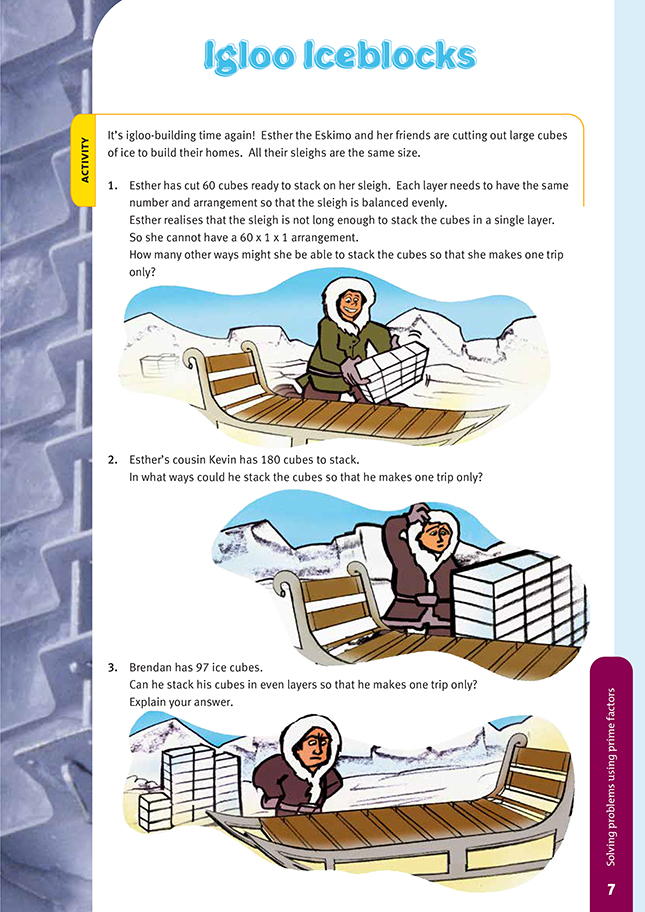This is a level 5 number link activity from the Figure It Out series. It relates to Stage 8 of the Number Framework.
A PDF of the student activity is included.
Click on the image to enlarge it. Click again to close. Download PDF (314 KB)
solve problems using prime factors
FIO, Link, Number, Book Four, Igloo Iceblock, page 7
The students can use the associative property (multiplicative strategies) to solve these problems by regrouping prime factors. Through the activities on previous pages, the students should have developed strategies for breaking down composite numbers into prime factor units (for example, factor trees, dividing up to square roots, and so on). An important feature of these problems is that the students need to realise that they should arrange the cubes in three dimensions. Therefore, three factors (other than 1) are needed to solve the problems.
It could be useful to introduce this idea with a simpler problem. For example, how many different arrangements can be made up from 12 cubes (other than a single-row arrangement)?
H L W
2 x 2 x 3
3 x 2 x 2
2 x 3 x 2
You can arrange the same dimensions in different ways and ask the students what they notice about these numbers. (They are all prime.)
Extending this to an exploration of 24 will establish that dimensions can be a mix of composite and prime numbers, but since all composite numbers can be expressed as a product of prime factors, prime factors are a good starting point for a systematic response using multiplicative strategies.
For example:
24 = 3 x 2 x 2 x 2
= 6 x 2 x 2 from (3 x 2) x 2 x 2
or 4 x 3 x 2 from (2 x 2) x 3 x 2
You can consolidate this activity by encouraging the students to write and share their own Igloo Iceblock problems
Answers to Activities
1. Using prime factors of 60 helps to find most of the possible arrangements.
60 = 2 x 2 x 3 x 5, so the possible arrangements using prime numbers are:
(2 x 2) x 3 x 5 = 4 x 3 x 5
(2 x 3) x 2 x 5 = 6 x 2 x 5
(2 x 5) x 2 x 3 = 10 x 2 x 3
(3 x 5) x 2 x 2 = 15 x 2 x 2
Other possible arrangements are 20 x 3 x 1 and 30 x 2 x 1.
2. The prime factors of 180 are 2 x 2 x 3 x 3 x 5.
Grouping these gives the following possibilities:
4 x 15 x 3, 4 x 9 x 5, 6 x 10 x 3, 6 x 6 x 5, 6 x 15 x 2, 10 x 9 x 2, 12 x 3 x 5, 18 x 2 x 5, 20 x 3 x 3, 30 x 3 x 2, 45 x 2 x 2.
Other possible arrangements are 1 x 4 x 45, 1 x 5 x 36, 1 x 6 x 30, 1 x 9 x 20, 1 x 10 x 18, and 1 x 12 x 15.
3. No. 97 is a prime number. The only factors are 97 and 1, and the sleigh is not long enough or wide enough to stack the cubes as a single layer.
